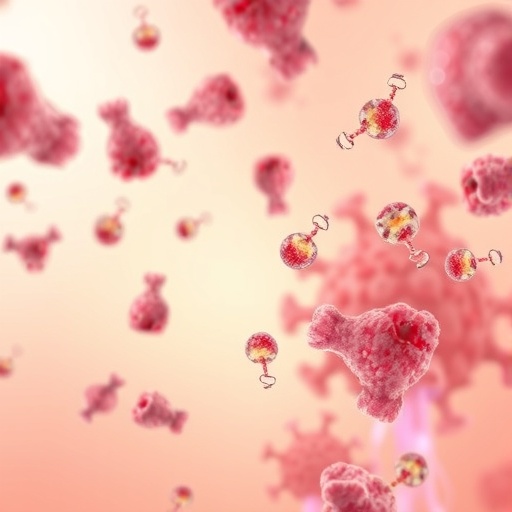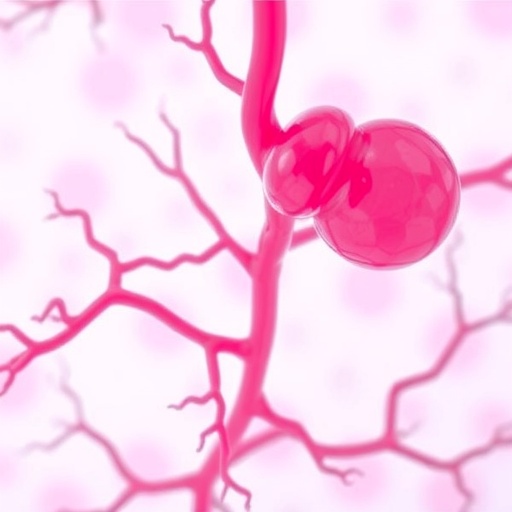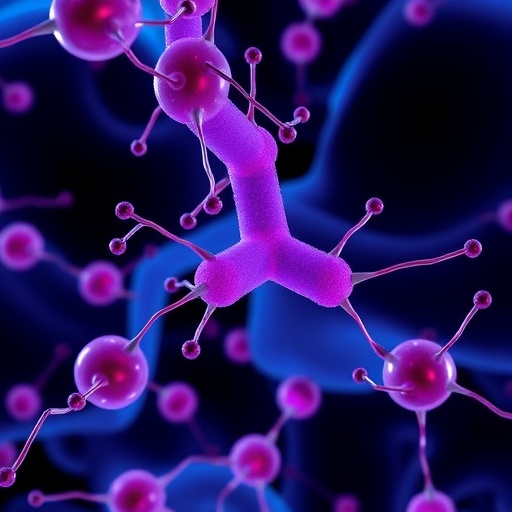In a groundbreaking study poised to reshape our understanding of allergic airway inflammation, researchers have uncovered a critical cellular mechanism involving lysosomal acidity and a protease, cathepsin L, that drives eosinophil activation through ARG1-mediated arginine metabolism. This novel insight opens new avenues for therapeutic strategies aimed at combating allergic respiratory diseases, conditions that impact millions globally and remain a significant healthcare burden.
The immune system’s eosinophils are key players in the body’s response to allergens, orchestrating inflammatory reactions that manifest as asthma or other allergic airway conditions. These white blood cells, while essential for defending against parasitic infections, can become pathological when excessively activated, contributing to chronic inflammation and tissue damage. The mechanisms that trigger eosinophil activation have long been the subject of intense investigation, given their therapeutic potential.
The team led by Han et al. embarked on a comprehensive exploration of cellular pathways within eosinophils, focusing on the role of lysosomal acidity—a property typically associated with the organelle’s degradative functions—and the enzyme cathepsin L, a potent cysteine protease localized largely within lysosomes. Their integrative approach combined cutting-edge molecular biology techniques, metabolic profiling, and in vivo models of allergic airway inflammation to elucidate how intracellular changes propagate immune activation.
Central to their discovery is the identification of ARG1, arginase 1, an enzyme that metabolizes arginine, an amino acid pivotal to several cellular functions including nitric oxide production and polyamine synthesis. By linking the catalytic activity of cathepsin L with an increase in lysosomal acidity, the researchers demonstrated that ARG1 expression is upregulated, leading to a metabolic shift in arginine utilization. This metabolic reprogramming primes eosinophils for heightened activation and inflammatory output.
The study’s methodology involved perturbing lysosomal pH experimentally and observing consequent effects on cathepsin L activity and ARG1 expression. Intriguingly, the elevation in lysosomal acidity potentiated the activation of cathepsin L, facilitating a cascade that culminated in the metabolic remodeling of arginine within eosinophils. This chain of events directly correlated with the cells’ ability to induce airway hyper-responsiveness and inflammatory infiltration, hallmark features of allergic airway disease.
To establish clinical relevance, the investigators analyzed airway samples from patients suffering from severe allergic asthma. Eosinophils extracted from these patients exhibited elevated lysosomal acidity, heightened cathepsin L activity, and amplified ARG1 expression compared to healthy controls. These findings underscore the translational significance of the lysosome-ARG1 axis in human disease, spotlighting a previously underappreciated metabolic underpinning of eosinophil-mediated pathology.
Mechanistically, the study uncovered that the arginine metabolism mediated by ARG1 diverges eosinophils from a nitric oxide-generating phenotype toward a polyamine-producing state. This shift influences cellular proliferation, survival, and the secretion of cytotoxic granules. The altered metabolic landscape not only enhances eosinophil persistence in inflamed tissues but also augments their capacity to exacerbate airway inflammation through increased release of inflammatory mediators.
Importantly, pharmacological or genetic interventions that reduce lysosomal acidity or inhibit cathepsin L markedly decreased ARG1 induction and attenuated eosinophil activation in preclinical models. This presents compelling evidence for the therapeutic potential of targeting lysosomal function and metabolism within immune cells to mitigate chronic allergic inflammation.
The nuanced understanding of lysosomal pH regulation’s impact on immune cell metabolism is a transformative insight that bridges the gap between cellular organelle dynamics and systemic immune responses. It challenges the conventional view of lysosomes merely as degradative compartments, highlighting their active role in modulating immune cell function via metabolic pathways.
This research also raises important questions about broader implications for other inflammatory diseases where eosinophils or similar immune cells contribute to pathology. Could the lysosomal acidity–cathepsin L–ARG1 circuit be a common theme across diverse immune-mediated disorders? Such inquiries pave the way for broader investigations that could revolutionize therapeutic strategies beyond allergic airway inflammation.
Moreover, the study highlights the importance of integrating metabolic biology into immunology, particularly the role of amino acid metabolism in shaping the innate immune landscape. The arginine metabolic pathway, manipulated through ARG1, emerges as a critical node linking metabolic and inflammatory networks within eosinophils.
Understanding eosinophil metabolic reprogramming also has ramifications for biomarker development. Elevated lysosomal acidity or activity of cathepsin L and ARG1 might serve as diagnostic or prognostic indicators, guiding clinical management and personalized treatment approaches in allergic airway diseases.
The interdisciplinary approach employed in this study—melding immunology, cell biology, biochemistry, and clinical research—exemplifies the future of biomedical breakthroughs. It underscores the power of dissecting cellular mechanisms at multiple biological layers to reveal hidden drivers of disease and identify novel intervention points.
As asthma and allergic airway conditions continue to rise globally, driven in part by environmental factors and genetic predispositions, innovative insights like these are urgently needed. The elucidation of the lysosomal acidity and arginine metabolism nexus offers newfound hope for future therapies that can precisely modulate eosinophil activity without broadly suppressing the immune system.
The implications of Han et al.’s discovery extend beyond immediate clinical relevance; they represent a paradigm shift in understanding immune cell activation. By unveiling how lysosomal microenvironmental changes orchestrate metabolic rewiring within eosinophils, this work redefines fundamental concepts of immunometabolism and cellular regulation within allergic inflammation.
Future directions should explore how this lysosome-centric regulatory mechanism interfaces with other signaling pathways and immune cells. Additionally, targeting cathepsin L or modulating lysosomal pH could be refined to achieve specificity and minimize potential side effects, an essential step toward therapeutic application.
In sum, this study heralds a new era of allergy research, where cellular metabolism and organelle dynamics converge to explain complex immune phenomena. The delicate balance of lysosomal acidity, enzyme activation, and metabolic reprogramming constitutes a crucial axis in eosinophil-mediated allergic airway inflammation, offering unprecedented targets for intervention amid the rising global challenge of allergic diseases.
Article References:
Han, Y., Li, N., Zhao, Y. et al. Lysosomal acidity and cathepsin L activate eosinophils via ARG1-mediated arginine metabolism in allergic airway inflammation. Nat Commun 16, 10451 (2025). https://doi.org/10.1038/s41467-025-65400-z
Image Credits: AI Generated
DOI: https://doi.org/10.1038/s41467-025-65400-z
Tags: allergic airway inflammation mechanismsARG1-mediated arginine metabolismcathepsin L protease in allergiescellular pathways in eosinophilschronic inflammation and tissue damageeosinophils in asthma treatmentimmune system response to allergensin vivo models of allergic inflammationlysosomal acidity and eosinophil activationmetabolic profiling in allergy researchmolecular biology techniques in immunologytherapeutic strategies for allergic diseases





